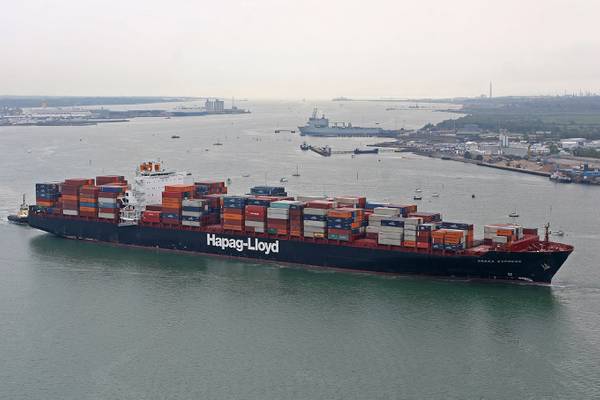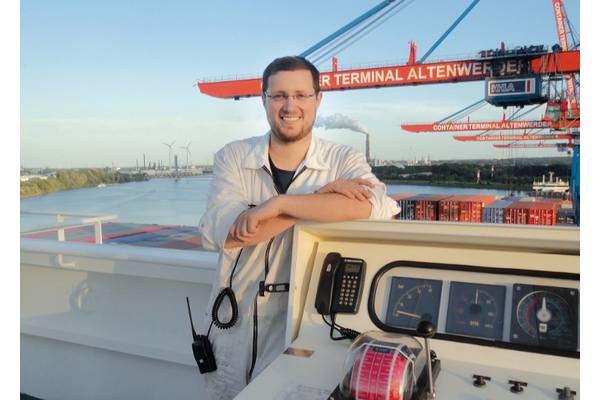Though raised in Germany’s industrial heartland, Philipp Wallutis has chosen to pursue a life at sea. Currently a second officer on board a Hapag-Lloyd ship, he might one day proudly wear the four stripes of a captain.
Never let it be said that parents shouldn’t interfere in their children’s career choices. As a teenager, Philipp Wallutis remembers watching a television documentary with his father, in which a captain navigated a ship through the Panama Canal. “‘Now that is a cool job,’ I said,” the 24-year-old recalls. His father then responded rather dryly, “Just go do it then!” to which Wallutis defiantly replied, “Yeah, I will, too!”
Less than a decade later, Wallutis made his dream come true. Although he isn’t a captain yet, he is well on his way to becoming one. He sails the world’s oceans, currently working as a second officer – the so-called “navigation officer” – on board the Osaka Express, one of the 188 containerships in the fleet of Hapag-Lloyd, Germany’s largest liner shipping company. He has also already sailed through the Panama Canal, which was one of the most fascinating experiences in his still-young career. What made it so fascinating wasn’t just the technical challenges involved in navigating this canal joining the Atlantic and the Pacific. “You’re actually sailing straight through the jungle,” he says. “And the starry sky over the Pacific! It was there that I really saw the Milky Way with the naked eye for the first time. That was stunningly beautiful.”
The episode with his father was not the first to bring Wallutis into contact with seafaring. As a boy, he joined a boat-racing club and learned how to sail on Lake Baldeney, south of the western German city of Essen. Still, his career choice was rather atypical for someone coming from the “Ruhrpott,” as Germans call this highly industrialized area known more for coal mines and steel mills than for sailing. The career advisor who put him into contact with Hapag-Lloyd five years ago was right about to go into retirement when she noted, “I once sent someone to sea at the very beginning of my career. And now you’re the second one!”
This is how things fell into place: In 2010, Wallutis decided to start a dual educational program – joining in-class instruction with on-the-job training – in nautical sciences at the University of Applied Sciences Emden/Leer, in the northwest corner of Germany . That same year, he went to sea on a containership for the first time, as an officer’s assistant. After finishing his studies last March, a traineeship now stands on his duty roster. This includes shorter and longer routes, some of which keep him at sea for up to three months at a time. And even if he is far from his family and girlfriend on those voyages, he never gets overly homesick. In fact, what really bothers him is that he can’t share his experiences with home. In addition to the glimpses he gets of foreign ports, countries and cities, there’s also the indescribable feeling that arises in the stillness and vastness of the ocean. “The likelihood of encountering other ships in the middle of the ocean is extremely low,” Wallutis notes.
Instead, there are what he calls other “traffic volumes,” such as the dolphins that swim in front of the ship, spurred on by the bow wave. “I’ve also already seen flying fish, turtles in the Caribbean, whales, orcas and even a beluga – a white whale,” Wallutis says enthusiastically – and fully aware of the fact that he leads an extraordinary life.
As his girlfriend will confirm, the young officer is more of a calm, even-tempered type than a passionate adventurer. He also has to be that way, seeing that he, the other two officers and the captain on board bear an enormous amount of responsibility – for the crew, for the cargo, for arriving in port on time, for precisely calculating the weather. The Osaka Express is currently conveying up to 7,000 containers, each of which can weigh up to 30 metric tons, from Hamburg to New York via Southampton. The estimated value of the goods on board is up to $1 billion.
Wallutis has been underway for five weeks, most of which has been spent out at sea. Every day, he stands on the bridge navigating the ship for about eight hours. It’s a good thing that he also remains level-headed while performing the more difficult tasks because, as anyone can imagine, things also get stormy sometimes on the high seas. “But our ship is also a monitoring station for the DWD, so we can’t really be surprised anymore,” he says in an immediately assuring voice, referring to Germany’s national meteorological service. The important thing is to make the right decisions based on the weather data, he explains, noting that what’s dangerous isn’t the wind that initially arises, but the subsequent formation of waves. And even if he admits to occasionally getting “a queasy feeling” when the waves reach 10 meters high, his composure instantly returns. “After all,” he says, “you know your own abilities.”
Practically anything imaginable can be transported by sea, whether it is turbines for commercial aircraft, flowers, food, furniture or everyday objects. “We have even transported stage parts for the band U2 while it was on its world tour,” Wallutis says.
However, there is a “blacklist” of things that aren’t allowed on the ship. This includes animals that deserve to be safeguarded even if they aren’t yet protected by international laws. For example, Hapag-Lloyd categorically refuses to transport whale or dolphin meat, shark fins or any products made from them. The same goes for sealskins or hunting trophies, such as lions or other large animals.
During long stretches at sea, short messaging services have made it easier to keep in contact with those back home. “At least you can use them to write a quick ‘Good morning!’ or ‘Good night!’” Wallutis explains. Or when you’re finally headed home, you can make dinner requests with them – such as “Just not fish!” – he adds with a laugh. But he doesn’t say this because he’s eaten too much fish on board. Nope. He just doesn’t like it.





